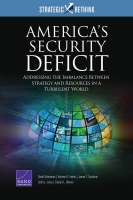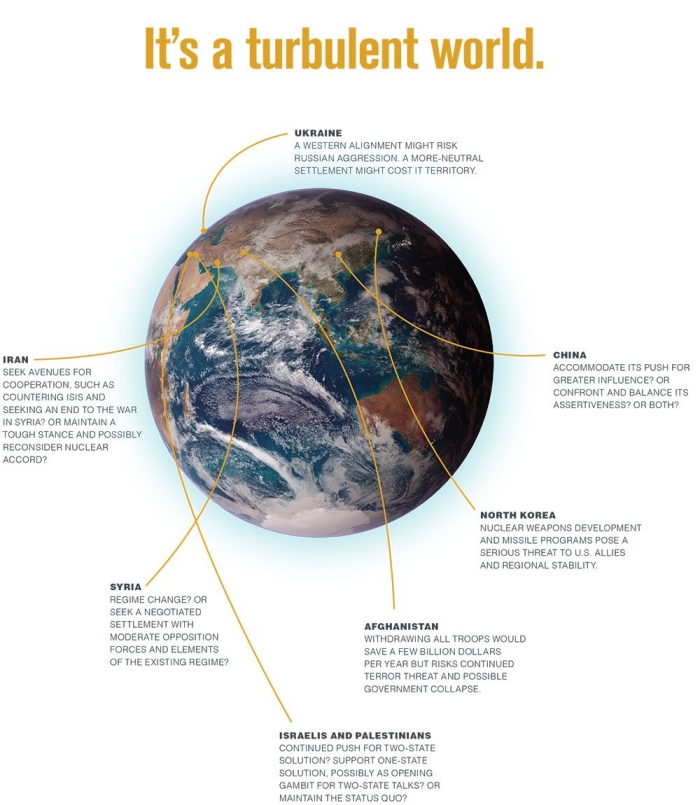America's Security Deficit: Addressing the Imbalance Between Strategy and Resources in a Turbulent World
Abstract
This report is the second in RAND's ongoing Strategic Rethink series, in which RAND experts explore the elements of a national strategy for the conduct of U.S. foreign and security policy in this administration and the next. The report analyzes defense options available to the United States in responding to the re-emergence of a belligerent Russia, the seizure of significant territory in Iraq and Syria by violent extremists, growing Chinese military power and assertiveness, and other threats to U.S. security and interests. It focuses on ways that the United States might adapt military instruments to meet these emerging challenges, assessing in broad terms the cost of defense investments commensurate with the interests at stake. The report argues that currently projected levels of defense spending are insufficient to meet the demands of an ambitious national security strategy.Key Findings
Limitations on defense spending in the context of emerging threats are creating a "security deficit."
Fielding military capabilities sufficient, in conjunction with those of our allies and partners, to deal with the disparate challenges faced by the United States will require substantial and sustained investments in a wide range of programs and initiatives well beyond what would be feasible under the terms of the Budget Control Act.America's Security Deficit: Addressing the Imbalance Between Strategy and Resources in a Turbulent World | RAND
Key Security Challenges
Europe
U.S. and NATO forces in Europe have
thus far made only modest adjustments to the new reality created by
Russian aggression in its "near abroad." War games of plausible
scenarios suggest that NATO would be unable, today, to prevent Russian
forces from invading and overrunning the Baltic countries in a matter of
days. Yet President Obama has renewed the U.S. promise to defend them.
East Asia
U.S. forces are increasingly
vulnerable to attack, principally by Chinese cruise and ballistic
missiles. American land-based air forces, fixed infrastructure ashore,
and naval surface vessels are particularly exposed. In a crisis,
Washington's efforts to bolster deterrence by sending more forces to the
region could backfire, provoking Beijing to attack lucrative targets
pre-emptively in order to seize the initiative.
Aging Nuclear Weapons
With the exception of the bomber
fleet, all major elements of the U.S. nuclear triad — intercontinental
ballistic missiles, nuclear submarines, and air-launched nuclear-armed
cruise missiles — are nearing the end of their service lives and will
have to be retired or replaced.
Poor Readiness
The readiness of U.S. forces today is
rather poor. The National Defense Panel, which was commissioned by
Congress to conduct an independent assessment of the 2014 Quadrennial
Defense Review, found that the Department of Defense faces "major
readiness shortfalls that will, absent a decisive reversal of course,
create the possibility of a hollow force that loses its best people."
This is due to the combined effects of nearly a decade and a half of
unremitting war in Afghanistan and Iraq and caps on defense spending
imposed by the 2011 Budget Control Act.


2 comments:
The present state of the alleged shortcomings of the US Army are the results of catastrophic incompetence in the process known as "Transformation" and as the program called "ARFORGEN".
Statistical analyses such as noted above have little relevance in combat readiness, that is the function of unit cohesion, and experience.
See my blogger blogs on Gordonswar regarding:
Death of an Army
http://gordonswar.blogspot.com/2015/10/arforgen-death-of-army.html
All Source Training.
http://gordonswar.blogspot.com/2015/10/all-source-training-gordon-s-fowkes-ltc.html
Post a Comment